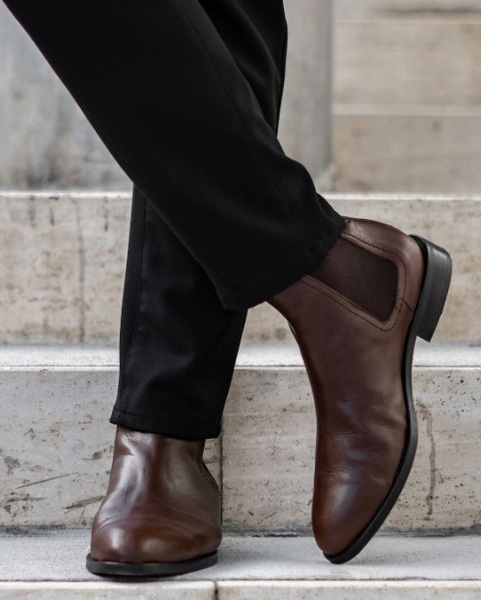Content Menu
● Introduction to Chelsea Boots
>> Leather vs. Suede Chelsea Boots
● Do Chelsea Boots Stretch?
>> Factors Influencing Stretching
● Methods to Stretch Chelsea Boots
>> 1. Wearing Thick Socks
>> 2. Using a Boot Stretcher
>> 3. Applying Heat
>> 4. Professional Stretching Services
>> 5. Stuffing with Socks or Shoe Trees
● Caring for Chelsea Boots
>> Leather Chelsea Boots:
>> Suede Chelsea Boots:
>> Storage:
● Common Fit Issues and Solutions
>> Tightness Around the Ankle
>> Heel Slippage
>> Narrow Toe Box
● Breaking in Chelsea Boots
● Conclusion
● FAQs
>> 1. How Much Will Chelsea Boots Stretch?
>> 2. Can I Stretch Chelsea Boots That Are Too Small?
>> 3. How Long Does It Take for Chelsea Boots to Break In?
>> 4. Can Chelsea Boots Be Stretched in Width?
>> 5. Will Stretching Chelsea Boots Ruin Them?
● Citations:
Chelsea boots are a timeless and versatile footwear option that has been a staple in many wardrobes for decades. One common question that arises when purchasing these boots is whether they will stretch out over time. In this comprehensive guide, we'll explore the stretching potential of Chelsea boots, methods to break them in, and how to care for them to ensure they maintain their shape and comfort.

Introduction to Chelsea Boots
Chelsea boots are characterized by their ankle-high design, elastic side panels, and a loop or tab at the back for easy wear. They are typically made from leather, which is known for its ability to mold to the wearer's foot over time. The elastic side panels also contribute to their flexibility and potential for stretching.
Leather vs. Suede Chelsea Boots
- Leather Chelsea Boots: These are durable and exude classic sophistication. Leather is known for its ability to stretch and mold to the foot over time, making it a popular choice for Chelsea boots. Leather Chelsea boots are versatile and can be dressed up or down, making them suitable for both formal and casual occasions.
- Suede Chelsea Boots: Suede is softer and more delicate, making it prone to stains and water damage. While suede can stretch slightly, it requires more care and protection compared to leather. Suede Chelsea boots add a touch of elegance to any outfit but require careful handling to maintain their luxurious appearance.
Do Chelsea Boots Stretch?
Yes, Chelsea boots do have the potential to stretch out over time. The natural properties of leather and the elastic side panels allow for some degree of stretching. However, the amount of stretching can vary depending on factors such as leather quality, boot construction, and wear frequency.
Factors Influencing Stretching
1. Leather Quality: Higher-quality leather tends to stretch more evenly and maintain its shape better. It is less prone to excessive stretching or losing its form over time.
2. Boot Construction: The way the boot is made can affect its ability to stretch. Boots with more flexible materials or designs may stretch more easily than those with stiffer constructions.
3. Wear Frequency: Regular wear can accelerate the stretching process. The more you wear your Chelsea boots, the faster they will mold to your feet.
4. Storage Conditions: Proper storage helps maintain the boot's shape. Keeping them away from direct sunlight and heat sources prevents drying out or fading, which can affect their ability to stretch.
Methods to Stretch Chelsea Boots
1. Wearing Thick Socks
One of the simplest ways to stretch your Chelsea boots is by wearing them with thick socks. This method helps to gently expand the leather, creating more room for your feet. It's recommended to walk around the house with thick socks on to help the leather mold to your foot shape.
2. Using a Boot Stretcher
A boot stretcher is a mechanical device designed to expand the leather of your boots. Simply place the stretcher inside the boot and adjust it to apply pressure to the areas that need stretching. Leave it in place for several hours or overnight for best results. This method is particularly effective for targeting tight spots like the toe box or instep.
3. Applying Heat
Using heat can help soften the leather and make it more pliable. Use a hairdryer to warm up the tight areas of your boots for about 5 minutes, keeping the dryer at least 5 inches away to avoid damaging the leather. Immediately after heating, wear the boots with thick socks to help mold them to your feet. This method should be used with caution to prevent overheating.
4. Professional Stretching Services
If you're uncomfortable stretching your boots at home, consider taking them to a professional cobbler. They have specialized tools and expertise to stretch your boots safely and effectively. This is especially recommended if you need significant adjustments or if you're unsure about the best stretching method.
5. Stuffing with Socks or Shoe Trees
When not wearing your boots, fill them with rolled-up socks or use a shoe tree to maintain their shape and gently stretch the leather. This method won't dramatically stretch the boots but helps maintain their form and can contribute to gradual stretching over time.

Caring for Chelsea Boots
Proper care is crucial for maintaining the shape and longevity of your Chelsea boots. Here are some essential care tips:
Leather Chelsea Boots:
1. Cleaning: Remove loose dirt with a soft brush or cloth, then use a mild leather cleaner in circular motions. Avoid harsh chemicals, and let your boots air dry naturally.
2. Conditioning: Apply a high-quality leather conditioner with a soft cloth, working it into the leather using small, circular motions. Let it absorb for 10-15 minutes before buffing away excess.
3. Polishing: Regular polishing is key for leather Chelsea boots. Choose a polish that matches your boots' color, apply in circular motions, and buff with a clean cloth to enhance both shine and protection.
Suede Chelsea Boots:
1. Cleaning: Gently brush away stains and dirt with a suede brush. For stubborn marks, use a suede eraser and avoid direct water application.
2. Protection: Use a dedicated suede protector spray to create a barrier against water and stains, ensuring the luxurious look of your suede Chelsea boots is preserved.
Storage:
- Use Shoe Trees: For leather Chelsea boots, insert shoe trees after wearing to maintain shape and absorb moisture.
- Store in a Cool, Dry Place: Keep your boots out of direct sunlight and away from heat sources to prevent drying out or fading. For suede boots, consider storing in a dust bag to protect against dust and light exposure.
Common Fit Issues and Solutions
Tightness Around the Ankle
If the elastic panels feel too tight, wearing thicker socks or using soft ankle pads can help reduce discomfort while the leather stretches.
Heel Slippage
Heel slippage occurs when the heel moves up and down inside the boot. To address this, look for boots with a higher heel counter for better support. Wearing thicker socks or using heel grips can also help reduce slippage.
Narrow Toe Box
If the toe area feels too narrow, consider opting for Chelsea boots with a wider toe box. Alternatively, you can try stretching the boots using thick socks and a shoe stretcher.
Breaking in Chelsea Boots
Breaking in Chelsea boots requires patience and the right techniques. Here are some methods to expedite the process:
1. Gradual Wear: Start by wearing your boots for short periods and gradually increase the time as they become more comfortable.
2. Leather Conditioning: Apply a leather conditioner to soften the leather and make it more pliable.
3. Boot Stretching: Use a boot stretcher to target tight areas and achieve a custom fit.
4. Heat Treatment: Use heat to soften the leather, but do so with caution to avoid damage.
5. Stuffing Technique: Fill your boots with socks or a shoe tree when not in use to maintain their shape and encourage gradual stretching.
Conclusion
Chelsea boots do have the potential to stretch out over time, primarily due to the natural properties of leather and the elastic side panels. While this stretching can improve comfort and fit, it's essential to start with a well-fitting boot and use appropriate breaking-in methods. Regular care and maintenance will help ensure your Chelsea boots retain their shape and comfort for years to come.

FAQs
1. How Much Will Chelsea Boots Stretch?
Chelsea boots typically stretch about a quarter to a half size, depending on the leather quality and construction. However, this can vary, and it's best not to rely on significant stretching when choosing your size.
2. Can I Stretch Chelsea Boots That Are Too Small?
While you can stretch Chelsea boots slightly, it's not recommended to purchase boots that are significantly too small. Stretching methods can help with minor fit issues, but they won't transform a boot that's a full size too small into a comfortable fit.
3. How Long Does It Take for Chelsea Boots to Break In?
The break-in period for Chelsea boots can vary, but typically it takes about 2-3 weeks of regular wear for the boots to fully mold to your feet. Some boots may feel comfortable right away, while others might take longer.
4. Can Chelsea Boots Be Stretched in Width?
Yes, Chelsea boots can be stretched in width to some extent. Using a boot stretcher or visiting a professional cobbler are effective methods for increasing the width of your boots.
5. Will Stretching Chelsea Boots Ruin Them?
When done properly, stretching Chelsea boots should not ruin them. However, overstretching or using harsh methods can potentially damage the leather or compromise the boot's structure. It's always best to use gentle methods and seek professional help if you're unsure.
Citations:
[1] https://www.sizechartguru.com/how-chelsea-boots-should-fit/
[2] https://www.oswinhyde.com/blogs/news/caring-for-your-chelsea-boots-tips-to-maintain-their-elegance
[3] https://www.panamajack.es/en/blogs/news/how-to-clean-chelsea-boots
[4] https://www.yinghuafootwear.com/how-to-break-in-chelsea-boots.html
[5] https://coveti.com/how-do-chelsea-boots-fit-on-men/
[6] https://www.yinghuafootwear.com/how-to-stretch-elastic-on-chelsea-boots.html
[7] https://www.aquila.com.au/style-guide/how-to-care-for-leather-boots
[8] https://bakershoe.com/blogs/news/the-complete-leather-boot-care-guide
[9] https://www.reddit.com/r/DocMartens/comments/y1811p/chelsea_boot_breakin_help/
[10] https://www.youtube.com/watch?v=iYFhECl-xNM
[11] https://chelseabootstore.com/how-to-break-in-your-chelsea-boots/
[12] https://chelseabootstore.com/shoe-care-guide/
[13] https://us.nps-solovair.com/pages/shoe-care-tips
[14] https://www.drmartens.com/us/en/guides/how-to-break-in-docs
[15] https://www.pavers.co.uk/blogs/how-should-chelsea-boots-fit
[16] https://nushoe.com/break-in-dr-martens-chelsea-boots/
[17] https://www.reddit.com/r/allenedmonds/comments/x2lh1y/proper_care_for_my_first_pair_of_liverpool/
[18] https://www.vagabond.com/en/about-us/the-care/
[19] https://www.overlookboots.com/blogs/boots/how-to-break-in-new-boots-the-right-way-dos-and-donts
[20] https://www.youtube.com/watch?v=R37v_lIYFO0

















